Georgia WWSCAN Biweekly Newsletter Update 1/19/24
Welcome to the bi-weekly update for WWSCAN partners in Georgia! The samples provided up through 1/11/24 have been processed in the lab and data are on the site at data.wastewaterscan.org.
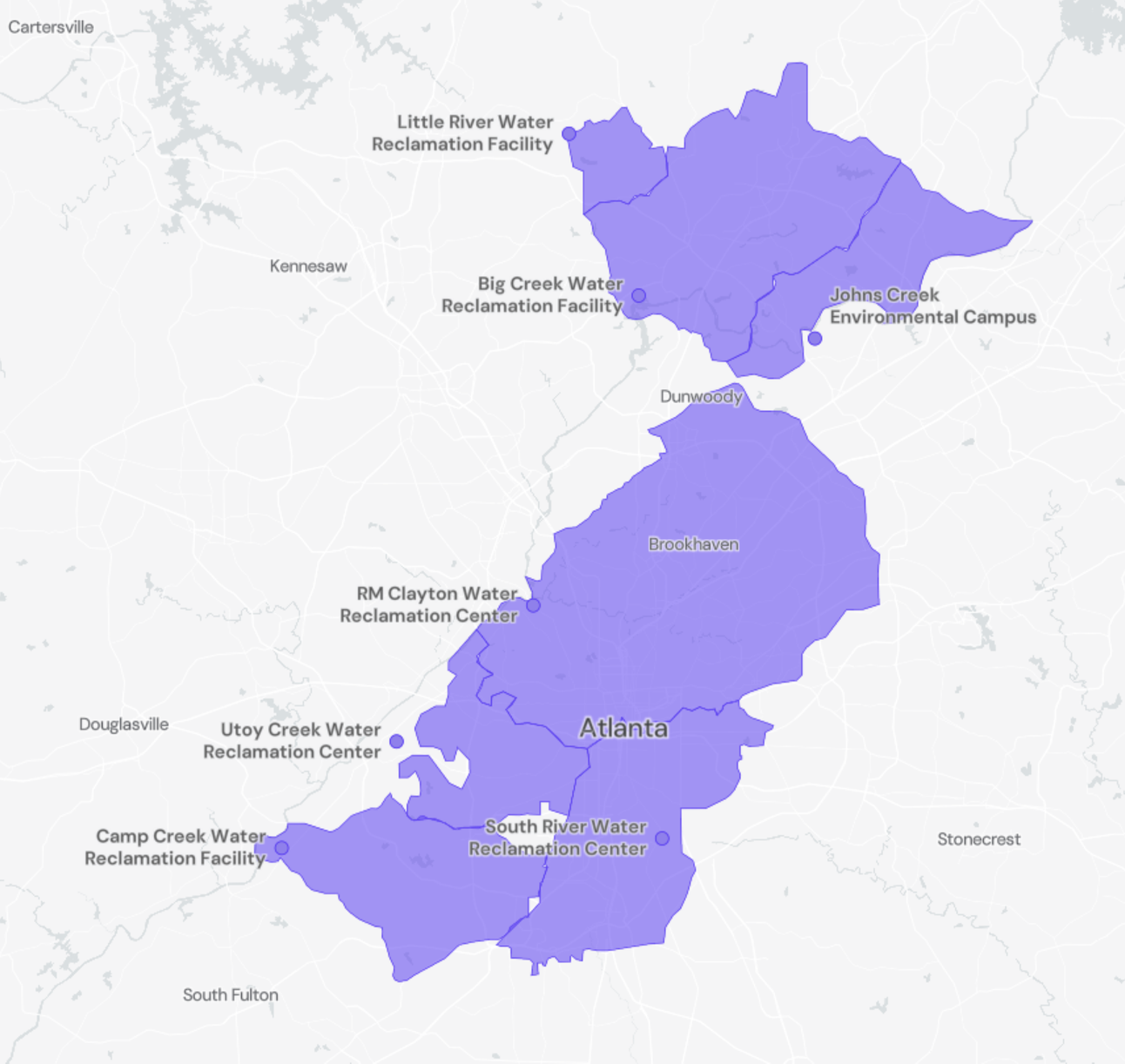
If you notice any bugs on the site or have any comments about it, please continue to send your feedback via email wwscan_stanford_emory@lists.stanford.edu. We thank you for your partnership!
Infectious Disease Target Review
Currently monitoring a suite of Respiratory, Gastrointestinal and Outbreak Pathogens of Concern

The methods for our assays are in the public domain and links for these are provided at the end of the newsletter. Please note that due to performance issues with the Influenza A assay, we have stopped testing for Adenovirus in early January to accommodate the necessary changes for Influenza A.
COVID-19
SARS-CoV-2 concentration in wastewater and sequencing for variants
SARS-CoV-2 RNA concentrations have been between 120,000 and 950,000 copies/gram in the last two weeks. The chart below shows the raw data over the last 365 days and the population-weighted aggregated trend line for all 8 Georgia sites when the data is normalized by PMMoV. The aggregated line and the National Levels benchmarks illustrate that SARS-CoV-2 N gene RNA concentrations among Georgia sites are within the upper third level of all concentrations measured in the last year.
As of 1/19/24, College Park, Columbus, Big Creek, Johns Creek, and Little River are in the HIGH (5 sites) category. There was not enough data to calculate a category for 3 sites (RM Clayton, South River, and Utoy Creek).
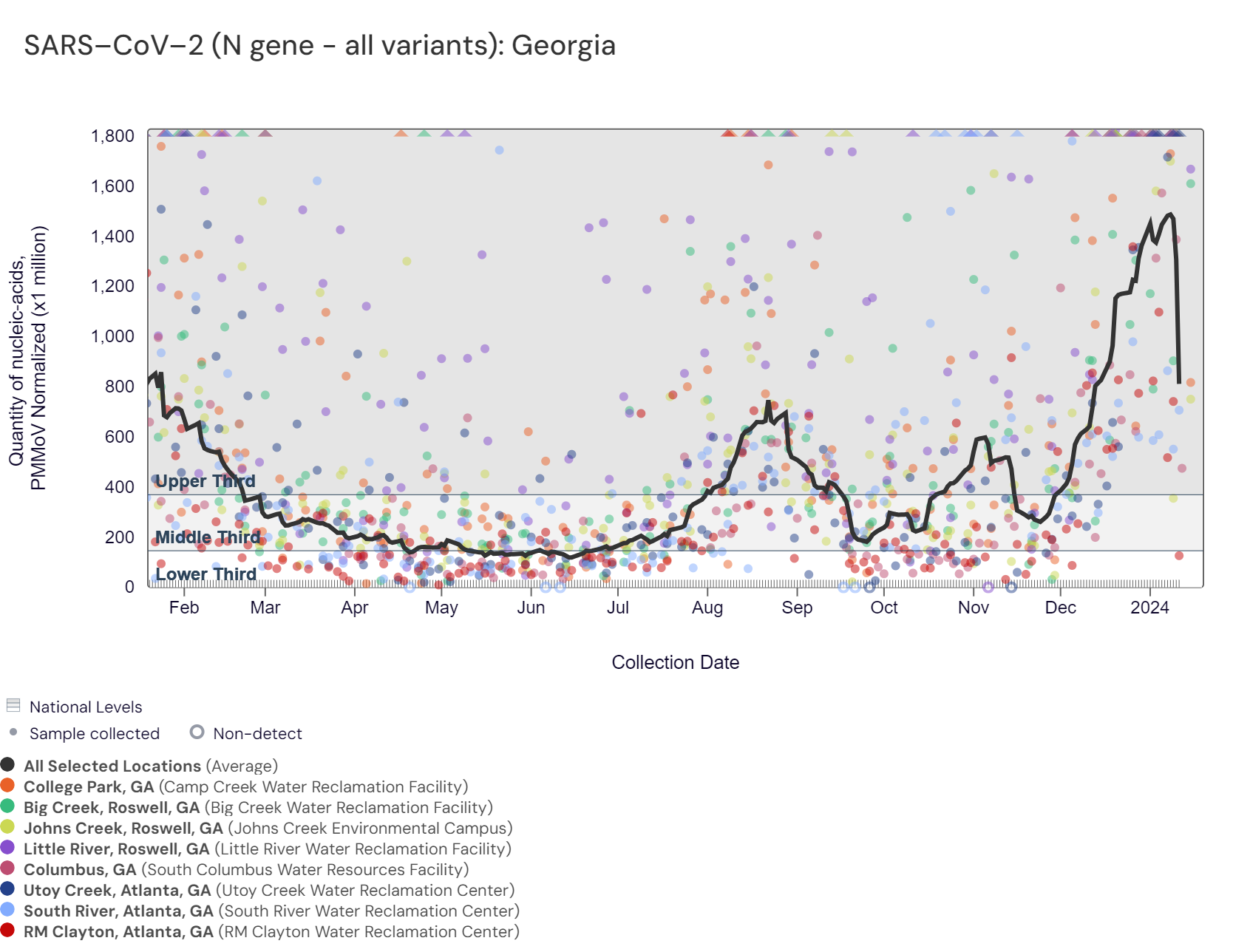
Sequencing of SARS-CoV-2 from wastewater is now available for RM Clayton and College Park (Camp Creek). The plots below show the relative proportions of different variants inferred from sequencing the entire genome of SARS-CoV-2 (Note: the sequencing variant plots are now available on the website, so the plots that are shown below are linked above if you want to interact with them). Please note that the large gap of "no data" for College Park is because we had data available from preliminary testing while finalizing site selection for sequencin, and then began weekly sequencing in the middle of December.
In the most recent samples, JN.1 (bright red) made up the largest proportion of the lineages detected at both sites (59.2% at College Park, and 37.2 at RM Clayton). Note that the sequencing data are always from samples taken between 1- 2 weeks ago. The most recent data are from the last week of Dec, so are about 2-3 weeks in the past. New data should be available soon.


Other Respiratory Pathogens
Influenza A and B, Respiratory Syncytial Virus, Human metapneumovirus, Human Parainfluenza & EV-D68
Influenza A: Last week we identified a technical issue with the fluorescent molecule on the influenza A assay probe that impacted the performance of our influenza A digital RT-PCR assay. All of the impacted data (1 Oct 2023 to approximately 11 Jan 2024) were removed from the website. We are now analyzing samples for influenza A RNA using a probe containing a different, better performing fluorescent molecule. This data is now available on the website, and recent trends will become clearer as more samples are processed.
Influenza B (IBV) RNA has been detected frequently at all Georgia sites at low up to high concentrations within the last month. Concentrations are currently below 40,000 copies/gram in the wastewater and levels are much higher than the last peaks in spring 2023. The highest concentrations have been detected at the Columbus site. As of 1/19/24, College Park, Columbus, Big Creek, and Johns Creek have had an onset of IBV in wastewater and are in the HIGH (4 sites) Wastewater Category. Little River is in the LOW (1 site) category. There was not enough data to calculate a category for 3 sites (RM Clayton, South River, and Utoy Creek).
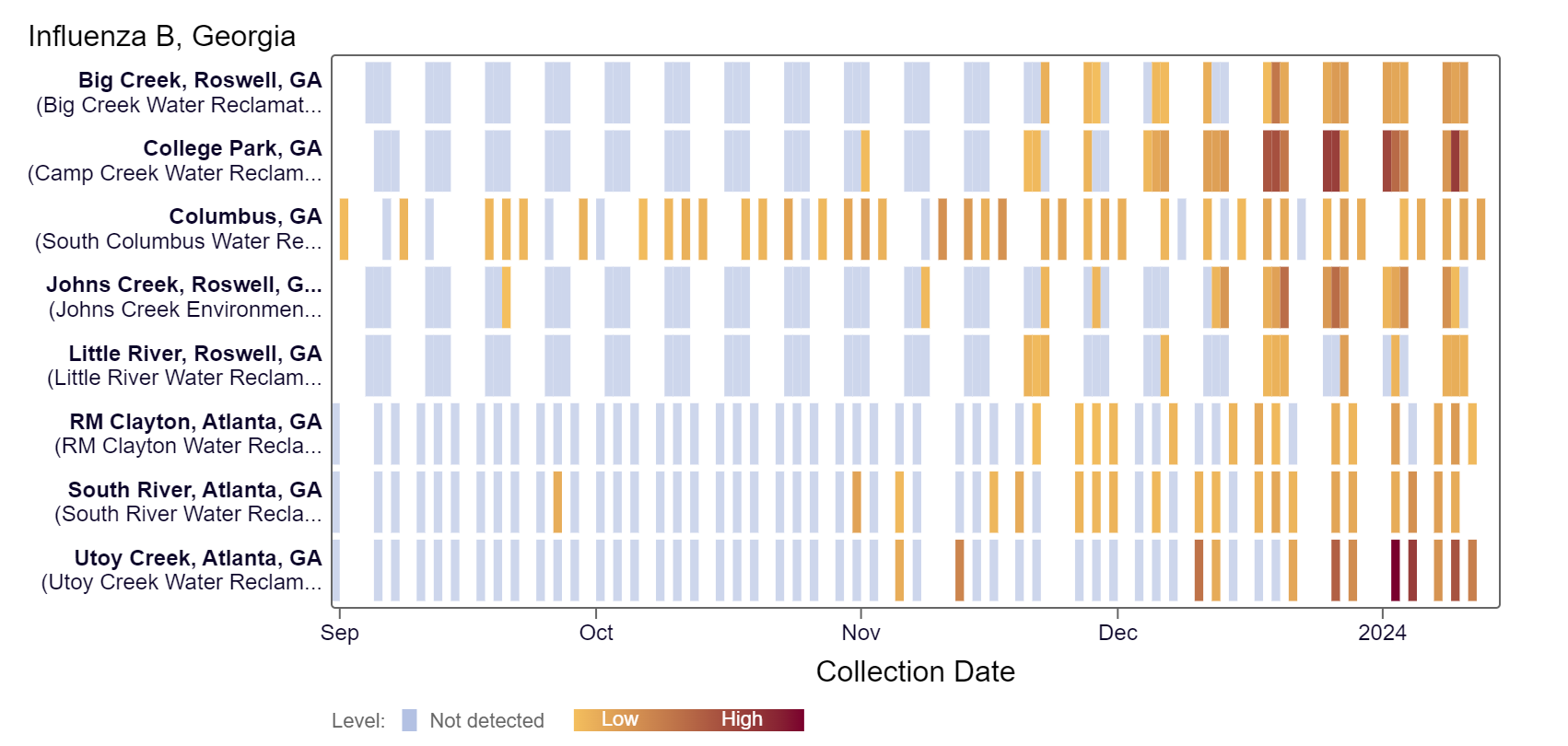
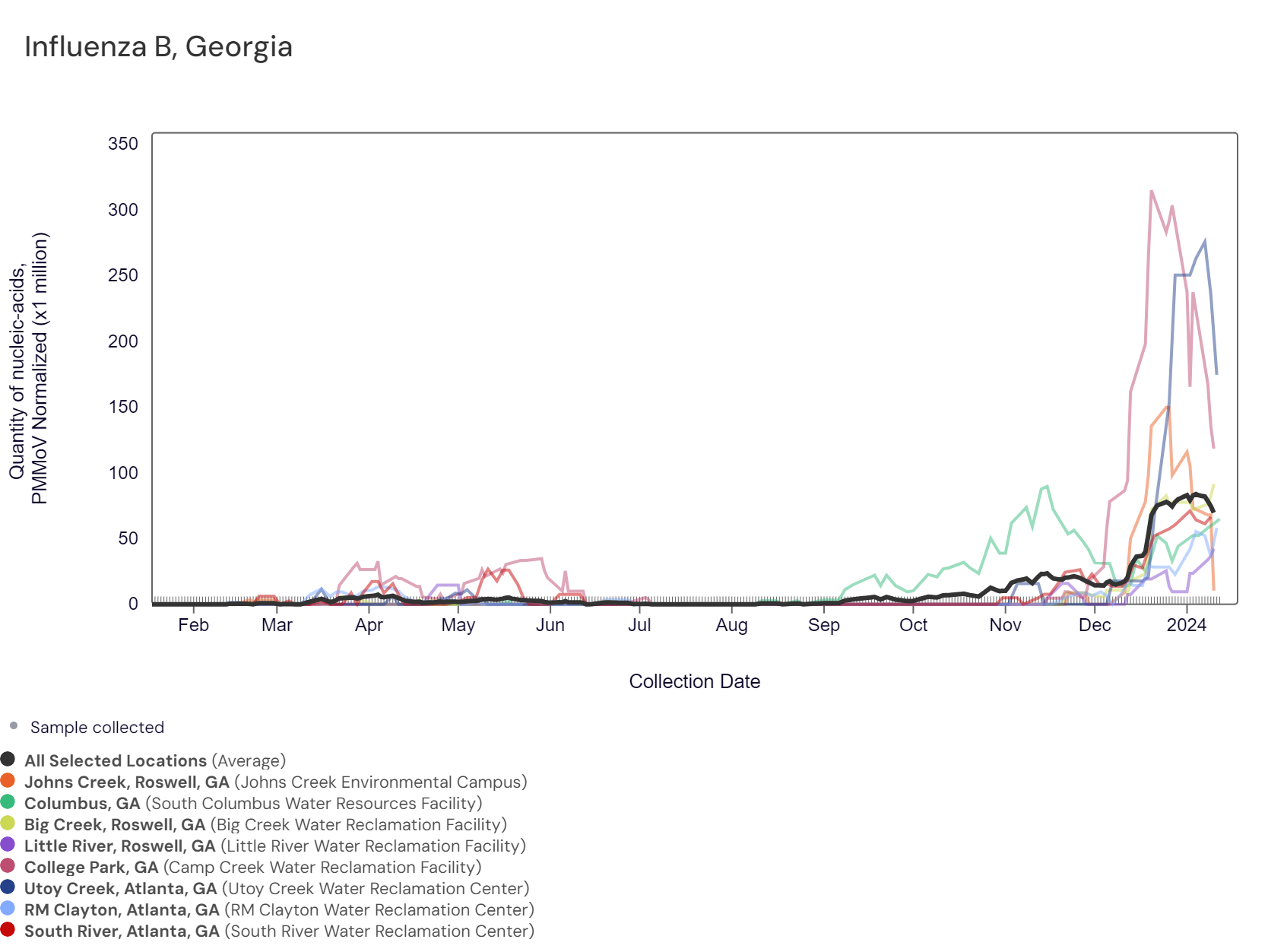
Respiratory syncytial virus (RSV) RNA concentrations were between 5,500 and 94,000 copies/gram over the last two weeks. The chart below includes the raw data for each site since January 2023. The aggregated line and the National Levels benchmarks illustrate that RSV RNA concentrations among Georgia sites are within the upper third level of all concentrations measured in the last year. Most Georgia sites are in the HIGH (5 sites) Wastewater Category as of 1/19/24. There was not enough data to calculate a category for 3 sites (RM Clayton, South River, and Utoy Creek).
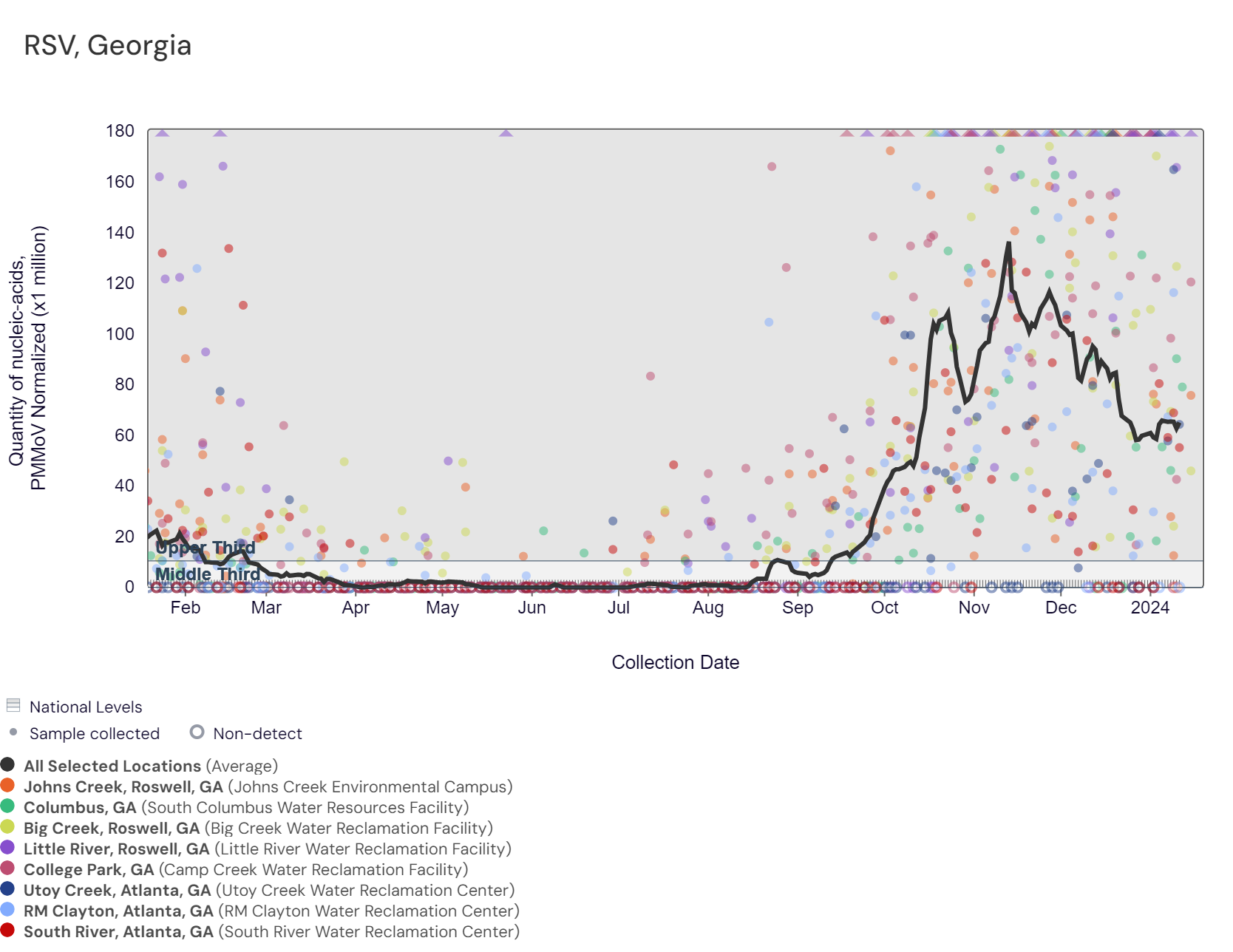
HMPV (human metapneumovirus) RNA concentrations are below 15,000 copies/g. The aggregated line and the National Levels benchmarks illustrate that HMPV RNA concentrations among Georgia sites are within the middle third level of all concentrations measured in the last year. College Park, Columbus, Big Creek, and Little River are in the LOW (4 sites) Wastewater Category and Johns Creek is in the HIGH (1 site) Wastewater Category (in onset), as of 1/19/24. There was not enough data to calculate a category for 3 sites (RM Clayton, South River, and Utoy Creek).
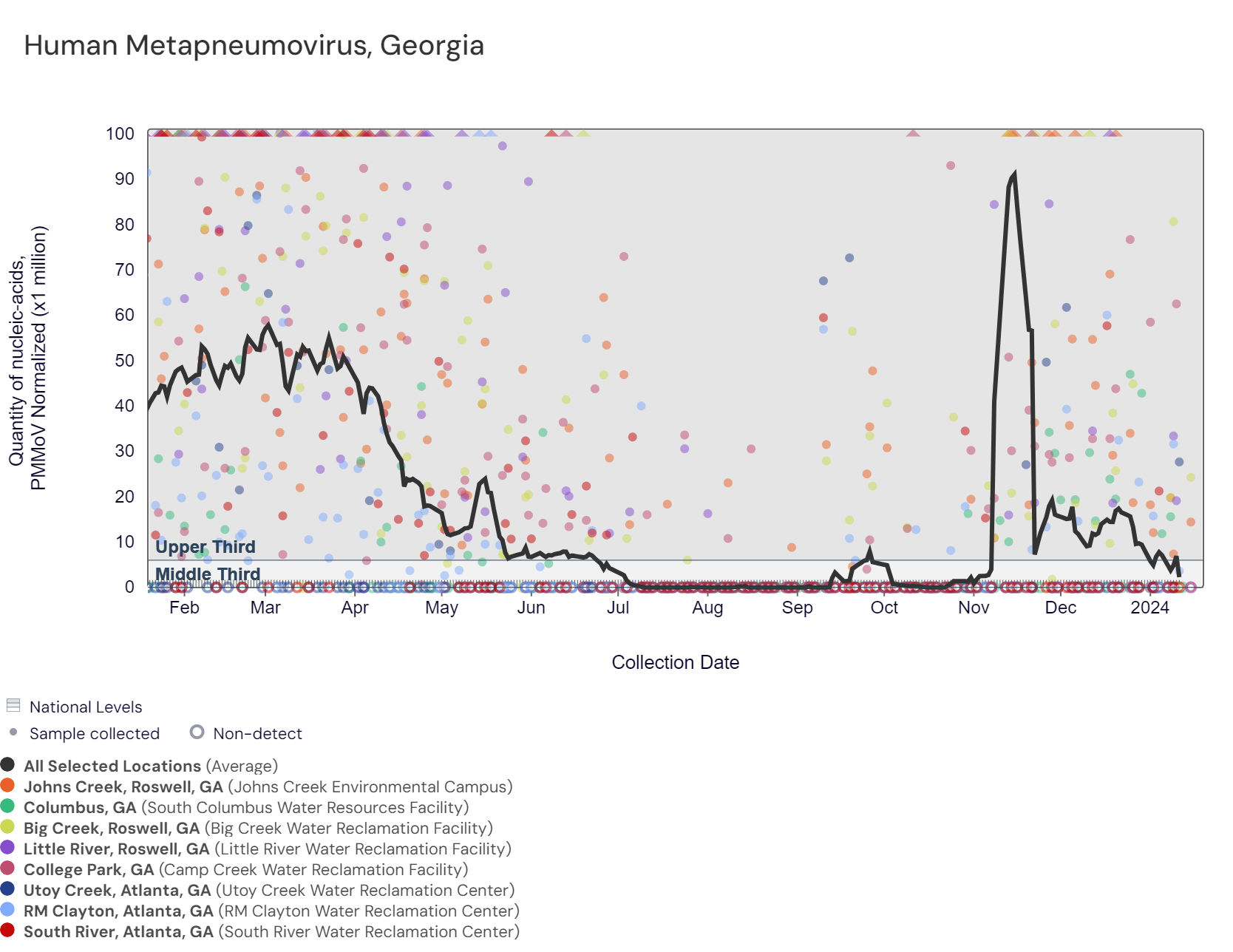
EV-D68 RNA is rarely detected at Georgia sites. There was a single detection at Johns Creek in the last two weeks, based on the heat map below. As a reminder, the color blue means the sample was non-detect for EV-D68 RNA and the colors get darker with higher concentrations. Because this is a newer target, there is no category assigned and we are still establishing what an expected baseline amount of detection will be.
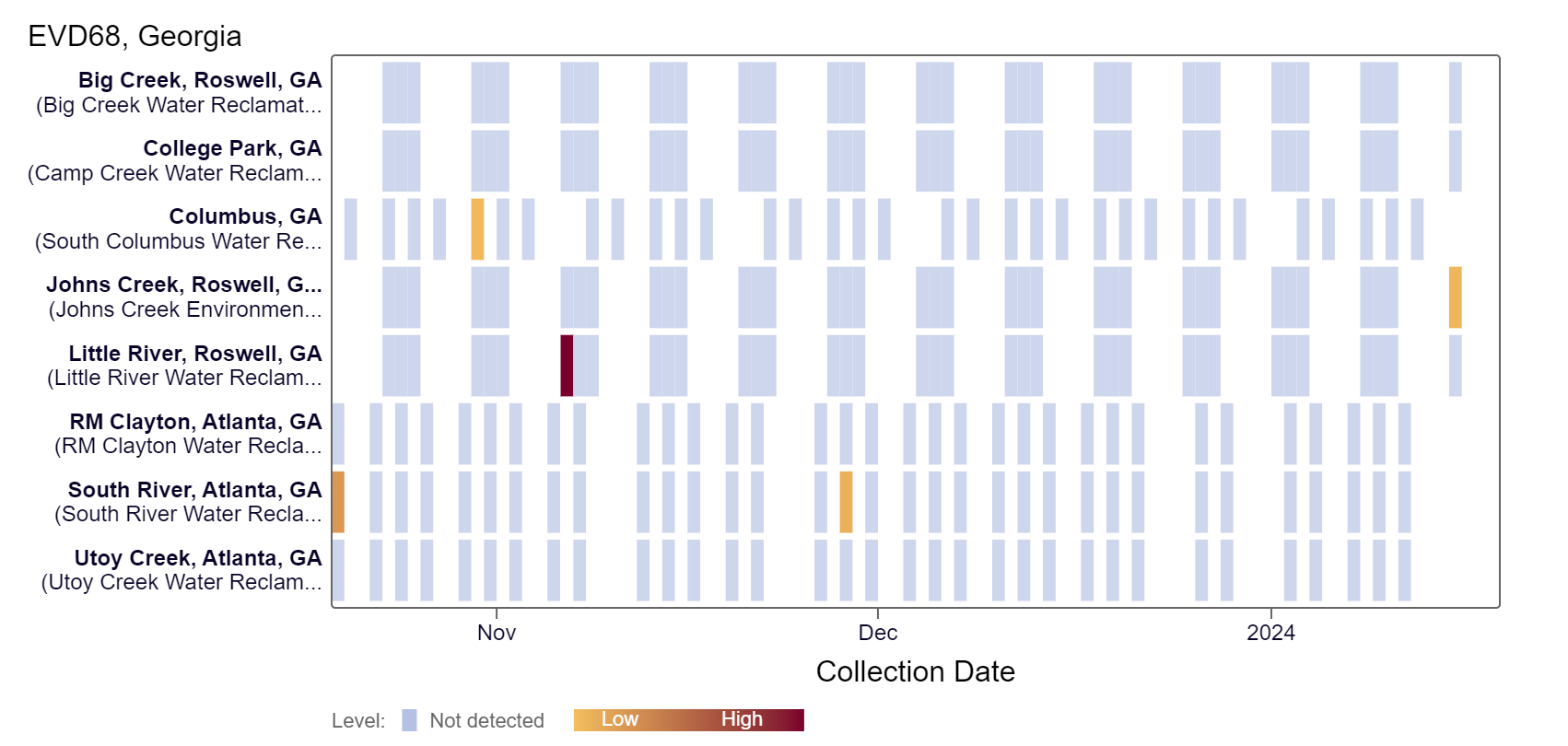
Parainfluenza RNA has been frequently detected in samples collected from Georgia sites. Concentrations have been low in the last two weeks and are less than 5,000 copies/g. The chart below shows the raw data and the population-weighted aggregated trend line for all 8 Georgia sites when the data is normalized by PMMoV. Because this is a newer target, there is no category assigned and we are still establishing what an expected baseline amount of detection will be.
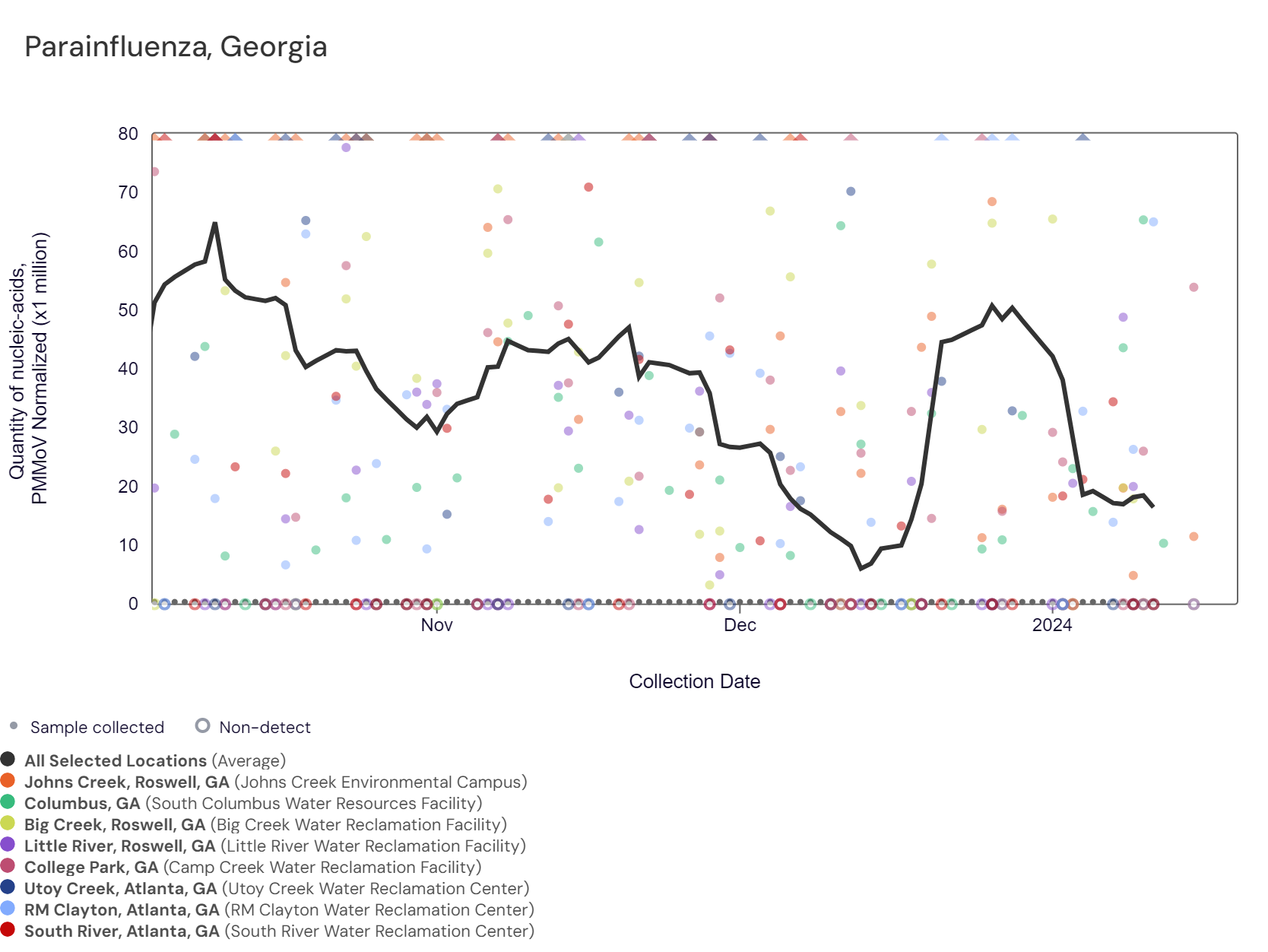
Gastrointestinal Pathogens
Norovirus GII and Rotavirus
Norovirus GII (HuNoV GII) RNA concentrations range between 6,000,000 - 30,000,000 copies/g and the population-weighted average line for the 8 Georgia sites is within the upper third level.
As of 1/19/2024, College Park, Columbus, Big Creek, Johns Creek, and Little River are in the HIGH (5 sites) Wastewater Category. There was not enough data to calculate a category for 3 sites (RM Clayton, South River, and Utoy Creek).
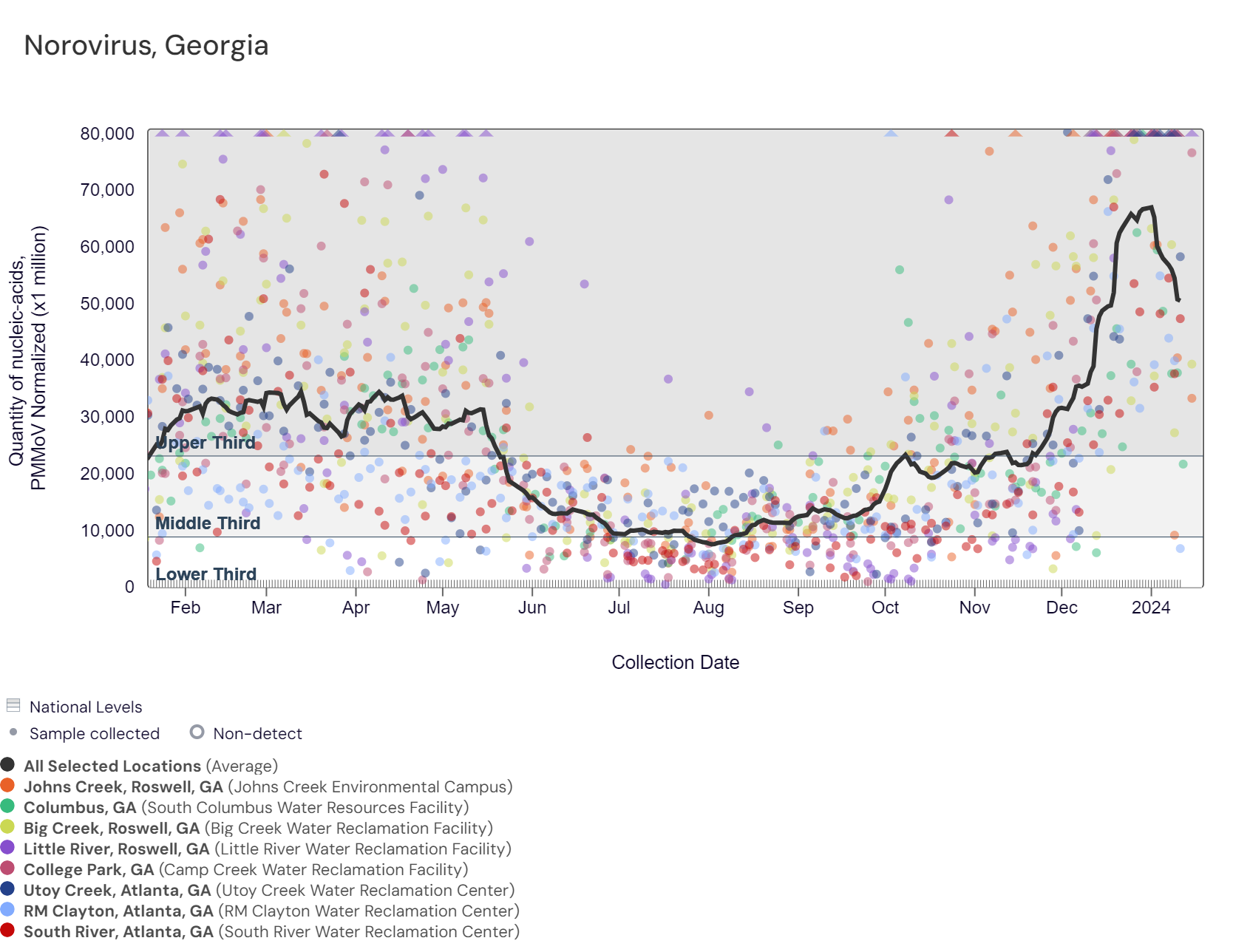
Rotavirus RNA concentrations have been between 120,000 - 2,200,000 copies/g over the last two weeks. The chart below shows the population-weighted average line is shown in black plus the raw data for each site. Because this is a new target, there is no category assigned and we are still establishing what an expected baseline amount of detection will be.
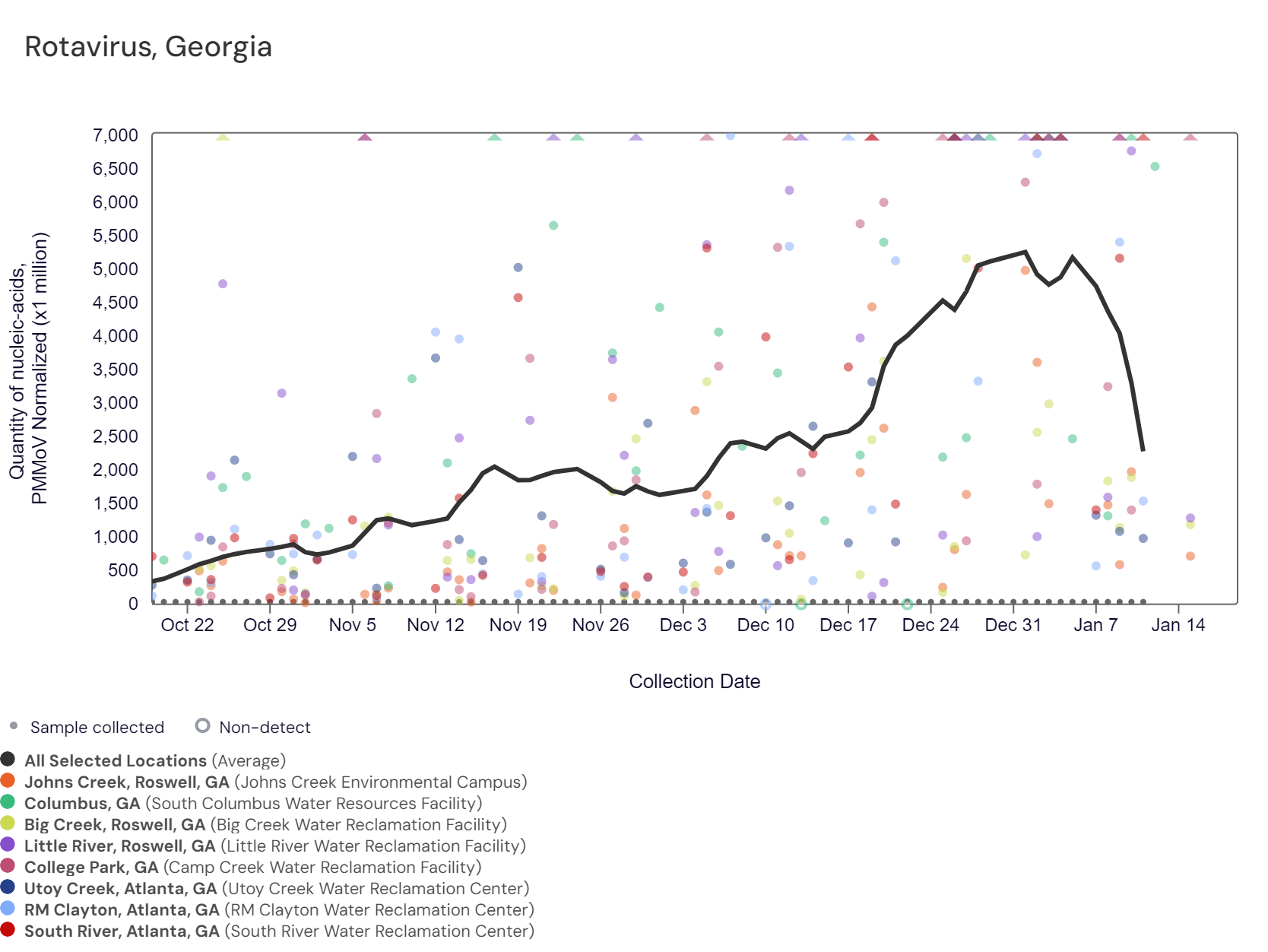
Other Pathogens of Concern
Mpox, Candida auris, and Hepatitis A
Mpox DNA results have been non-detect at most sites in the last 21 days. This heat map shows data since July 2022. Sites are labeled in the rows and each date a sample was collected as a column. The color blue means the sample was non-detect for mpox DNA and the color maroon means Mpox DNA was detected. White indicates no sample was collected. There are 5 Georgia sites in the LOW Wastewater Category as of 1/19/24.

Candida auris DNA has only been detected at the Columbus site in the last two weeks, based on the heat map below. Because this is a new target, there is no category assigned and we are still establishing what an expected baseline amount of detection will be.
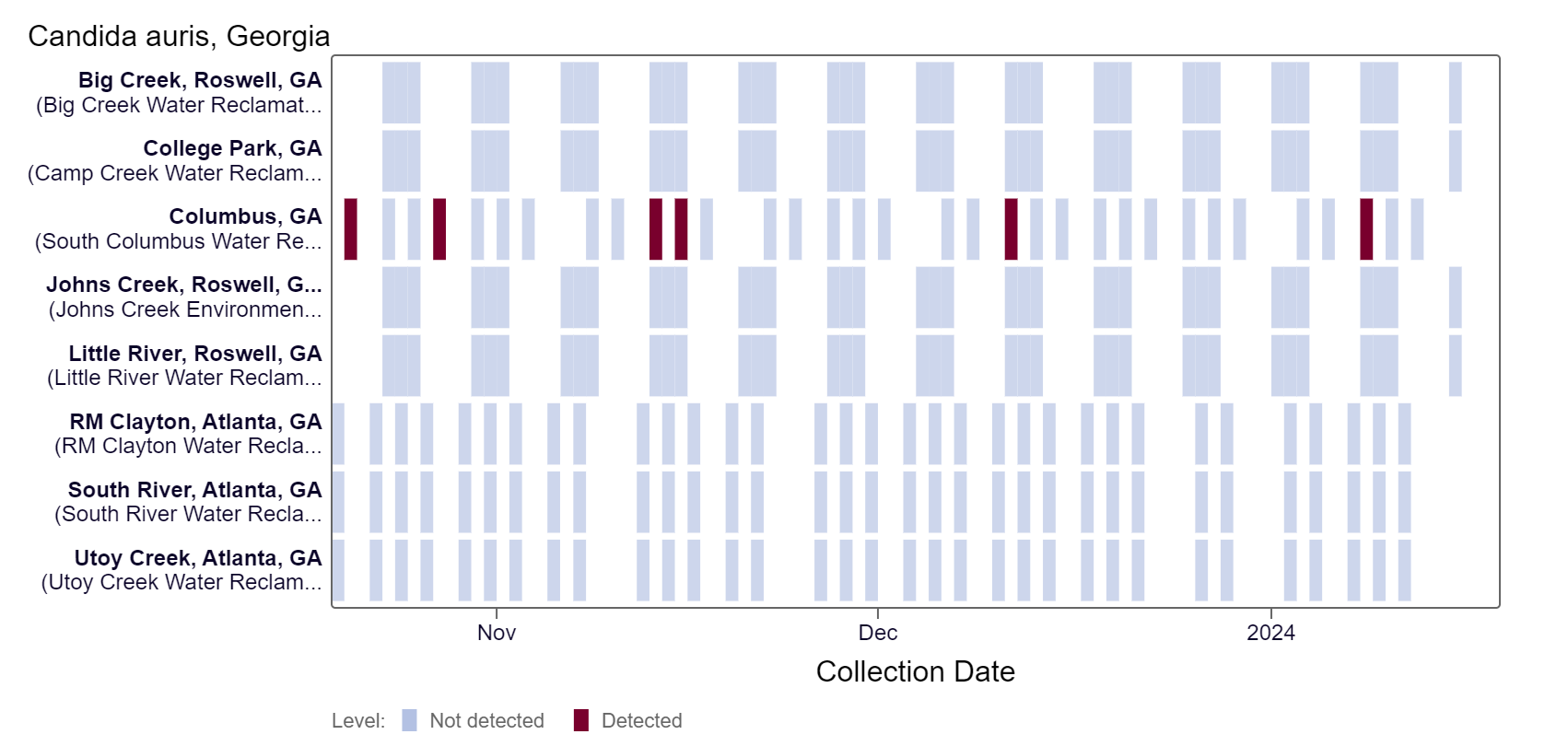
Hepatitis A RNA has not been detected in the last two weeks. Because this is a new target, there is no category assigned and we are still establishing what an expected baseline amount of detection will be.
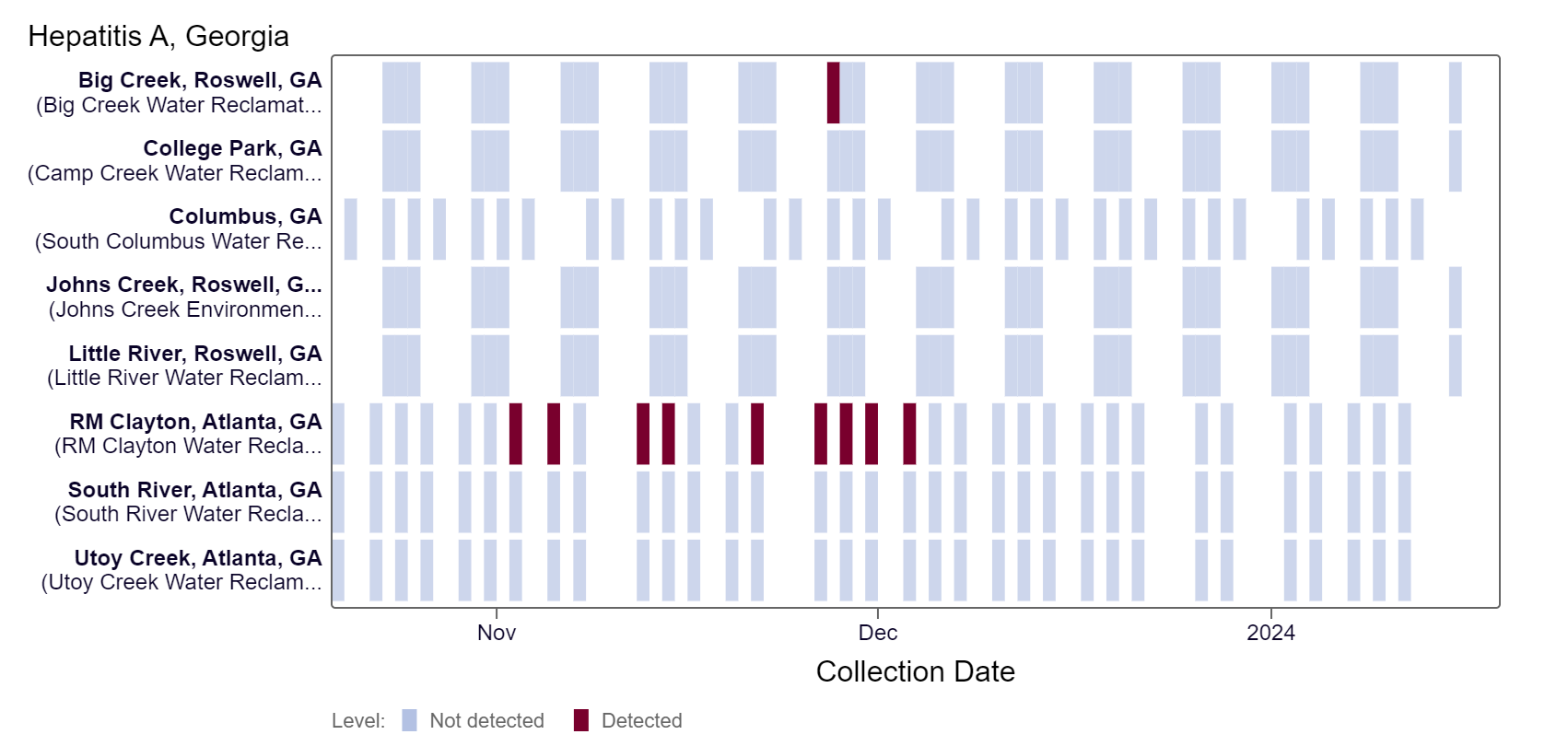
WWSCAN protocols and methods in peer reviewed publications
Protocols (Pre-analytical methods and SARS-CoV-2 analytical methods including controls):
- High Throughput RNA Extraction and PCR Inhibitor Removal of Settled Solids for Wastewater Surveillance of SARS-CoV-2 RNA
- High Throughput pre-analytical processing of wastewater settled solids for SARS-CoV-2 RNA analyses
- Quantification of SARS-CoV-2 variant mutations (HV69-70, E484K/N501Y, del156-157/R158G, del143-145, LPPA24S, S:477-505, and ORF1a Del 141-143) in settled solids using digital RT-PCR
- High Throughput SARS-COV-2, PMMoV, and BCoV quantification in settled solids using digital RT-PCR
Pre-prints and peer-reviewed publications provided WWSCAN methods:
- SARS-CoV-2
- Influenza, Human metapneumovirus, Respiratory syncytial virus, Human parainfluenza
- Mpox
- Norovirus GII
- Adenovirus group F, Rotavirus, Candida auris, Hepatitis A
- Enterovirus D68
Related News
The next stakeholder meeting will take place Friday, February 9th @ 12 PM EST. You can use this zoom link to join. Hope to see you there!
